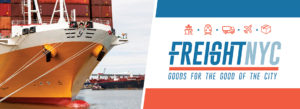This week New York City unveiled a $100 million plan to overhaul the city’s aging urban freight systems through strategic investments to modernize their maritime and rail assets and create new distribution facilities, with the ultimate goals of creating nearly 5,000 jobs for New Yorkers and a more sustainable and resilient city logistics network.
“Freight NYC is an investment in our city’s future,” said Mayor de Blasio. “By modernizing our approach to shipping, we will create thousands of good-paying jobs while keeping our streets safer and cleaner.”
NYC depends on crucial but aging marine, rail and highway infrastructure and relies upon trucks to move nearly 90% of freight. As the City’s population continues to grow and consumers increasingly demand near-instant deliveries, local freight volumes will grow an estimated 68% by 2045, further choking traffic and impeding commerce. This challenge is particularly acute in the “last mile” of distribution, in which trucks bring goods from port facilities and central warehouses, often located in neighboring states like New Jersey, to consumers over city streets and arteries.
“Freight NYC is one of the most ambitious re-imaginings of how 8.5 million New Yorkers – and the tens of millions more in our region – share, sell, and buy the goods that keep our economy thriving,” said Deputy Mayor for Housing and Economic Development Alicia Glen. “It will modernize our shipping sector, strengthen our economy, and improve the air we breathe.”
“Freight NYC will better equip New York City to meet 21st-century demand by modernizing the city’s freight infrastructure, reducing truck traffic and improving air quality –while creating nearly 5,000 good-paying jobs in the process,” said NYCEDC President and CEO James Patchett. “This plan is a win-win for our environment and economy, and we will continue to work with our partners in government, sister agencies and industry stakeholders to transform the City’s freight distribution system and create a more sustainable and resilient supply chain.”
Last year alone, traffic congestion cost the local economy $862M, hurting local businesses and impeding commerce. Through Freight NYC, the de Blasio Administration and its partners are acting to protect the environment, traffic systems, and regional economy in the decades to come.
In addition to investing in existing maritime and rail assets, the City will work with private partners to build new modern distribution, transload, and warehousing facilities, and to promote and incentivize the use of environmentally-friendly green trucks for last mile delivery. In total, Freight NYC will remove 15,000 vehicles’ worth of CO2 per year, ultimately helping to improve air quality and reduce asthma rates.
Three key points
Freight NYC is aiming at an end-to-end solution to the city’s infrastructure based on three key points:
1. An investment in multimodal operations
The plan will include revised marine terminals and barging operations as well as expanding rail lines and freight facilities. For example, underutilized rail lines will receive new facilities within existing rights-of-way and new passing lanes to alleviate track congestion.
2. New freight distribution hubs
New distribution, warehousing and trainload facilities will be built to meet increasing demand. For example, requests for proposal will be released to build a 500,000-square-foot facility at the Brooklyn Army Terminal and a 4-acre site near JFK Airport to develop an air cargo and distribution facility.
3. Last mile emissions
NYC will encourage deployment of cutting-edge and emission-free trucks on city streets for last-mile delivery. The goal is to reduce 80% of gas emissions by 2050.
New York clearly is taking the lead in a critical situation for commerce, the supply chain and the public. Other municipalities should take note.
Source: NYC

